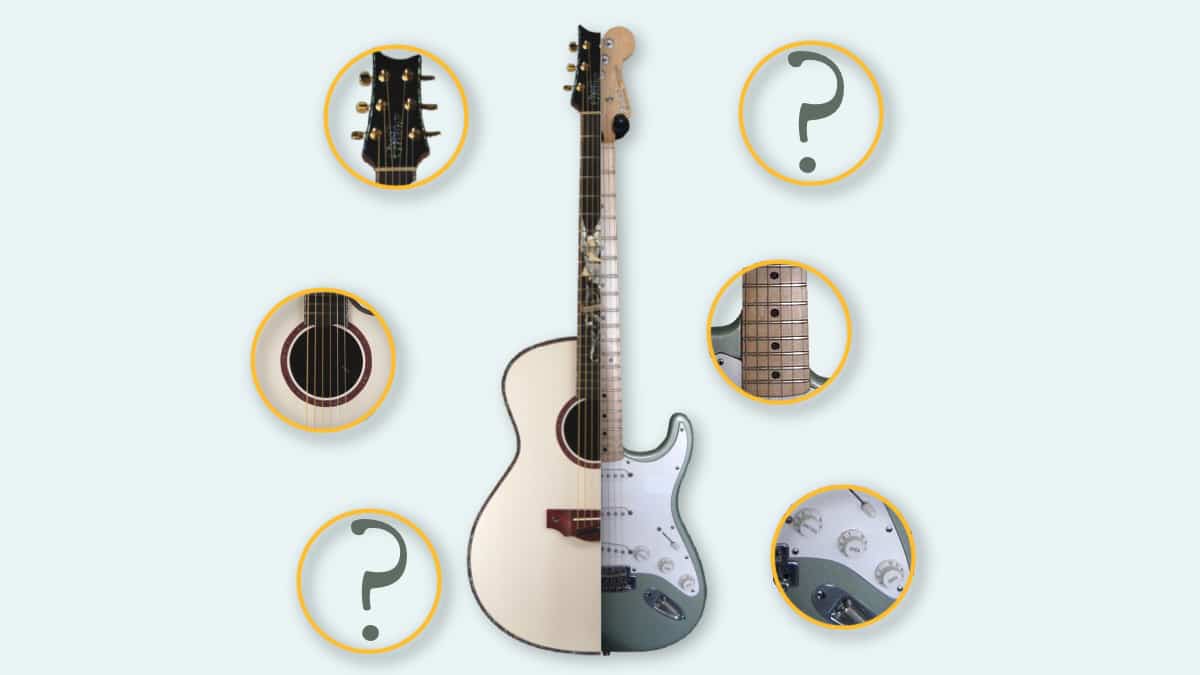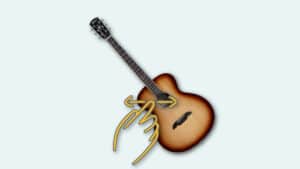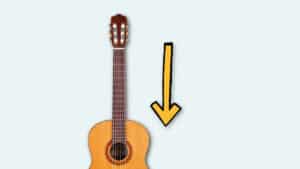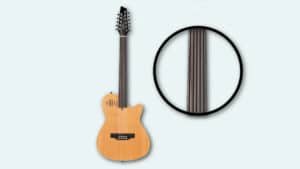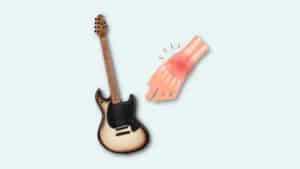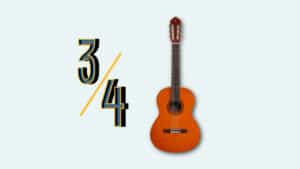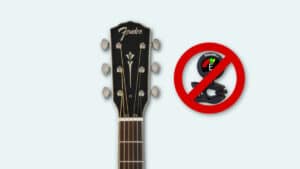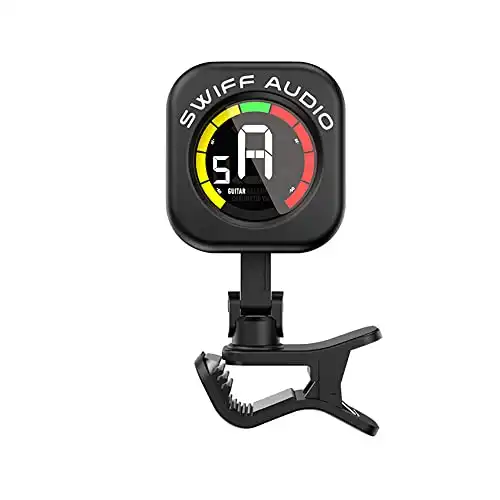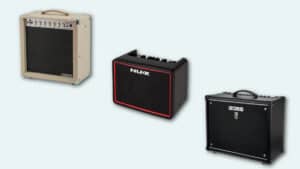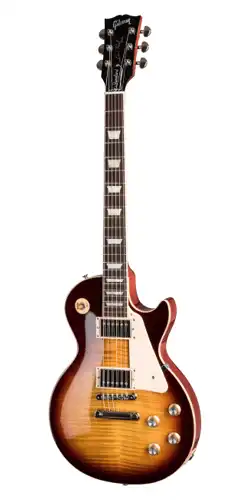You’ve ripped open your Yamaha box to find a new, shiny guitar.
But when you look up songs to learn on YouTube, the teachers are talking about frets, bridges, tuning, and more. Suddenly, you’re lost.
What you need is a lesson on guitar anatomy. Buckle up, and let’s explore.
You’ve Got Your Guitar…Now What? 8 Parts of A Guitar
1. The Guitar Body Produces Sound
The body of the guitar is the wooden base that attaches to the neck and strings. It’s the wooden piece that you hold and rest your elbows on while you strum the strings.
Surprisingly, the body’s wood type plays a major role in determining the sound and sound quality. The higher quality wood, the more complex the sound will be. This is especially true for acoustic guitars. Why? Acoustic guitars rely on wood shape and type to produce sound (versus electric that also relies on pickups).
Additionally, the body shape plays a big role, too. For example, a hollow body produces much warmer tones (which is great for blues or jazz). Alternatively, solid bodies are great at producing bright, crisp tones. Solid bodies also boast great sustain with very little feedback.
2. Bridges Support the Strings
The guitar bridge is the piece of equipment that supports the strings. It transmits the string vibrations to other components of your guitar to produce sound, such as the sound hole or the pickups.
There are four main types of bridges players can use: fixed, floating, tremolo, and stop tail.
Many players prefer floating bridges since they offer much more flexibility in tone. Still, other bridge types offer solid tones, too.
3. The Fretboard Is Where the Magic Happens
The fretboard is where the frets start and end. Basically, it’s where all playable music, tones, and notes occur. The fretboard is not to be confused with the neck of the guitar, as the neck of the guitar counts for the material above and below your fretboard.
The spaces between your frets are known as intervals. If there is a large distance between specific frets, the interval is larger. And, as you guessed, if there is a smaller distance between specific frets, that makes the interval smaller.
4. Frets Are Where You Put Your Fingers
Pick up your guitar: do you see those little segments all along the fretboard? These are individual frets. What fret you put your fingers on dictates the sound and notes of the music.
As the frets get closer to the body of the guitar, the fret shape becomes smaller, and the sound becomes higher pitched. If you’re looking for higher notes and higher sound, place your fingers on the smallest frets right by the bridge of your guitar.
Some beginner players buy fret markers to help them keep track of which fret is what. Of course, that’s also what your position markers do. Still, fret markers can help you keep track of different notes.
5. Position Markers Keep You On Track
If you look at your guitar, you’ll see tiny little dots marking the edge of your fretboard and on some of the actual frets. These position markers help you remember which fret is which while you play.
Why do these exist? The more you play, the more you’ll realize how easy it is to get lost on your fretboard. Each fret produces a drastically different sound. One wrong placement can throw off your entire “Suck My Kiss” solo riff. No one wants that.
Next time you’re playing, and you get lost on your fretboard, check out those position markers to anchor yourself back on track.
6. Pickguards Protect Your Guitars’ Body
Imagine this: you’re wailing on your guitar and throwing out insane riffs when you look down to see scribbles all over your guitar’s body! You then see your pick and notice that the tip has rubbed away. You realize you’ve used your pick to draw all over your guitar.
This, my friends, is why we have pick guards. The pick guard is a piece of plastic on top of your guitar’s body to protect your pick from marking your guitar.
While most guitars have a pick guard, some don’t. Whether or not you need a guard depends on personal preference. Some players (like Robbie Krieger) play with only their fingers. If this is the case, you don’t need a pick guard, as your fingers will never enact the level of damage that a plastic pick will.
And, if you do find yourself with those marks, you can always get rid of them by picking up buffing gel or scratch remover. Just make sure to do your due research. Some bodies are more sensitive than others, and the last thing you want to do is damage your guitar more than the pick has.
If your guitar does not come with a pick guard and you want one, you can always buy and install them yourself.
7. The Sound Hole Produces Sound
The guitar sound hole is, you guessed it, where your guitar produces sound. Sound holes are only present in acoustic guitars, as electric guitars make and convert sound through pickups.
How do sound holes create sound? When you strike your guitar strings, that hollow cutout collects the sound waves and gives them space to reverberate. The sound hole then releases the vibrations, amplifying the sound waves into listenable music.
8. Tuning Keys Keep Your Guitar Sounding Good
What is an instrument without tuning keys?
Tuning keys are the metal knobs on your guitar head that adjust the tightness of your strings. Twisting them higher or lower alters the pitch and tunes an out-of-tune instrument.
Why do strings go out of tune? The more you play your guitar, the more pressure the strings are under and the more out of tune they become.
It’s essential to keep your instrument tuned so that your guitar sounds good. Check out this video that shows you how to tune a guitar. Or, if you want to make life easier, you can always buy an automatic guitar tuner, like the Swiff A12-CS Instrument Tuner.
SWIFF Tuner has dedicated modes for Guitar (Acoustic ,Electric), Bass, Violin, and Ukulele and offers a Chromatic mode that allows for key changes (Bb, C, D, Eb, F) so you can tune any string, brass or woodwind instrument.
4 Parts of an Electric Guitar
While most of the parts of an electric guitar are the same, there are some features electric guitars have that acoustics do not.
Here are some elements that an electric guitar has that you won’t find on an acoustic.
1. Output Jack Keeps A Crisp Sound
It may seem like a simple piece on your instrument, but the output jack is one of the most vital equipment. This is the piece of equipment that transmits the signals to the instrument cable. You can tell when you have a bad (or worn down) jack when it makes a pop, sizzle, and static noise.
If you hear your guitar making static sounds, it’s more than likely that the issue lies in your output jack.
2. Volume Control Maintains Correct Loudness and Tone
On the body of your guitar, close to the pickups, there should be a knob that allows you to change your guitar’s volume without walking all the way over to your amplifier. When you crank that knob to the max, you’re sending the maximum pickup signal to your amplifier.
Even though this knob controls the volume, modifying the volume can also help you sculpt tone. For example, if you’re playing at a thick distorted tone but still want it to be audible, you can dial the volume down to get a thinner tone.
3. Pickups Make Electric Guitars Audible
Where would we be without guitar pickups? If you’ve ever played your electric guitar without the amp, you know how important pickups are.
Your pickups are what translates your guitar’s vibrations into electrical signals. These signals move to the amplifier, which boosts levels to audible, actual sounds.
How do these magical tools work? Most pickups use magnetics.
When you strum your electric guitar, the pickups use electromagnetic induction to harness the string vibrations into electrical signals.
If that all sounds a little confusing, don’t worry. You don’t have to know the ins and outs of how pickups work. All you need to know is that different pickups offer different types of sound. And, depending on what sound you want to play, will inform what pickup you want.
There are two main pickup types. The first is a single-coil, and that pickup gives off a sharper, crisper, and brighter tone. These treble-focused sounds cut through mixes. As a result, they have been used by such legends as Jimi Hendrix, Eric Clapton, and Kurt Cobain.
The other pickup type is a double-coil pickup (often referred to as a humbucker). Humbuckers cancel out the 60 Hz hum from single coils by winding up single coils to reverse the polarity. This produces high power and strong bass, and crunch.
As you might imagine, double-coil pickups are popular in heavy metal, hard rock, blues rock, and jazz. Looking for a humbucker? Check out Gibson Les Paul Standards or a Gibson SG. But these are expensive— wait to buy these models until you feel more confident as a player.
The new Les Paul™ Standard returns to the classic design that made it relevant, played, and loved -- shaping sound across generations and genres of music.
4. Pickup Selector Switch
A pickup selector switch is a fantastic tool that allows you to modify the profile of your guitar’s tone with the flick of a button.
Located on the guitar’s body (usually next to the volume button), the pickup selector switch is a built-in capability that allows you to switch from different frequencies that alternate between bass and treble tones.
That’s The Show!
There are many benefits to understanding your guitar’s anatomy.
The most significant advantage is that once you better understand your guitar’s anatomy, you’ll become the master of your instrument. You’ll better learn songs, you’ll be able to keep up with teachers and other players, and you’ll gain much more confidence in your abilities as a player.
FAQs
What is the space between the two frets called?
The spaces between frets are the guitars’ intervals. The bigger the distance between frets, the bigger the interval.
What are the parts on a guitar called?
The major parts of a guitar are the body, neck, headstock, tuning pegs, frets, strings, sound hole, and bridge.
What is the structure of a guitar?
Guitars have two primary structures: the neck and the body. Of course, many other pieces go into a guitar’s construction. Other elements like the strings, sound hole, and frets allow you to play music.

